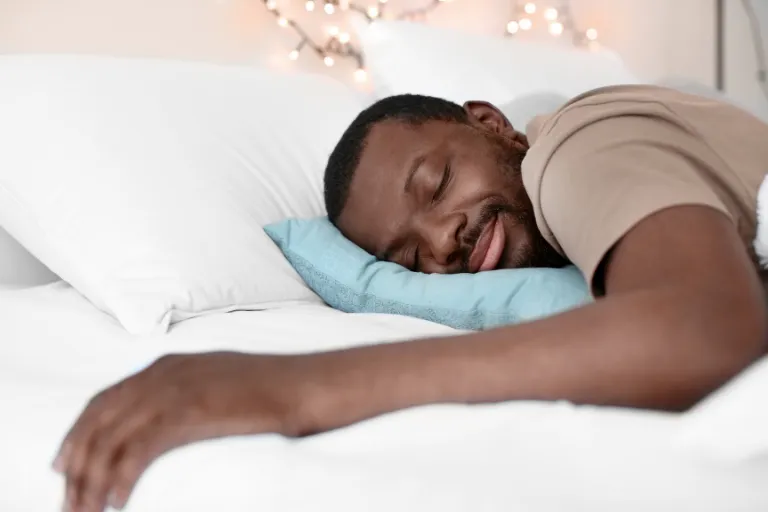How Sleeping With Blue or White Light Affects Sleep Quality
Sleeping with lights on—especially blue or white light—can seriously disrupt sleep patterns. Light signals your brain that it’s daytime, suppressing melatonin, the hormone that helps you fall asleep. Exposure to these light colours can delay sleep onset, reduce deep sleep, and lead to more frequent awakenings.
Studies have shown that blue light from devices or LED bulbs significantly impacts your sleep cycle. It lowers melatonin levels, making it harder to stay asleep. White light, though softer, still has enough blue spectrum to interfere with your natural rhythm.
Actionable Tip: Replace bedside lights with warm, amber-coloured bulbs. These emit less blue light, allowing your body to naturally prepare for rest.
Subscribe for Free for more insightful health articles tailored to your needs.
Why Warm Light Colours Support Better Sleep
Warm hues—like red, amber, or dim orange—have the least effect on melatonin production. These colours mimic the natural glow of firelight or sunsets, which signal the brain to wind down.
Users dealing with chronic tiredness or sleep problems often find it easier to rest when using dim, warm lighting in the evening. These calming tones can also reduce anxious thoughts and heart palpitations linked to overstimulation at night.
Actionable Tip: If you wake up in the night, avoid switching on overhead lights. Instead, use a low-lumen, amber-coloured night light to reduce disruption.
The Science Behind Light Sensitivity and Sleep Patterns
Your internal clock, or circadian rhythm, responds to light cues. Bright, cool lights trick your body into staying alert, even if it’s bedtime. This mismatch can trigger chronic symptoms like difficulty concentrating, joint pain flare-ups, and irregular blood sugar regulation.
Scientific research indicates that consistent exposure to artificial light at night is associated with poor user outcomes, especially in those experiencing trauma or widespread pain. Even brief light exposure while sleeping can reduce time spent in REM sleep—important for emotional regulation and memory.
Actionable Tip: Limit screen time at least one hour before bed. If necessary, use a blue light filter or “night mode” on your device.
Room Lighting Design for Sleep Quality: What Works Best
To optimise your bedroom for restorative sleep, pay attention to the type, position, and timing of light sources. A poorly placed ceiling light or harsh bedside lamp may keep your body in “wake mode” even as you try to relax.
Use layered lighting that lets you adjust brightness levels easily. Dimmer switches, blackout curtains, and motion-sensitive amber night lights can help maintain a sleep-friendly environment.
Actionable Tip: Keep your bedroom lighting under 200 lux in the evening. During sleep, total darkness—or close to it—leads to better sleep quality and fewer interruptions.
How Light Exposure Affects Children and Teens
Younger users are especially sensitive to the effects of light. Sleeping with lights on may worsen attention problems or cause morning grogginess. Teens, in particular, need deep, consistent sleep for mood regulation and academic performance.
Studies have shown that exposure to blue or white light during sleep disrupts the brain’s slow-wave activity in young people. This can lead to restless nights, delayed sleep phases, and reduced energy the next day.
Actionable Tip: Encourage a tech-free bedroom rule for children. Use wall-mounted amber lights for reading before bed instead of overhead or blue-toned bulbs.
Subscribe for Free for more insightful health articles tailored to your needs.
Simple Lifestyle Adjustments to Improve Sleep Quality
Improving your sleep environment doesn’t always mean spending money. Often, the most effective changes are free and practical:
- Stick to a consistent bedtime.
- Dim the lights 1–2 hours before bed.
- Avoid caffeine and alcohol in the evening.
- Use blackout curtains or eye masks.
- Keep electronics out of the bedroom.
These habits help your body recognise when it’s time to rest, making it easier to fall asleep and stay asleep.
Actionable Tip: Use a simple timer to dim your room lights automatically every evening. This trains your internal clock over time.
Conclusion
Your light environment plays a major role in how well you sleep. Choosing the right light colours, reducing exposure at night, and designing a bedroom that supports rest can all make a difference. Whether you’re dealing with sleep problems, chronic tiredness, or anxious thoughts, adjusting your lighting is a simple yet powerful tool. Try these actionable changes tonight—and track how you feel in the morning.
Want to improve your sleep starting tonight?
Swap out your white bulbs for warm ones, dim your lights early, and power down your screens before bed. Small changes lead to lasting rest.
This blog post aims to be informational and should not replace professional medical advice. Always consult with a healthcare provider for personalised advice.
Subscribe for Free for more insightful health articles tailored to your needs.



